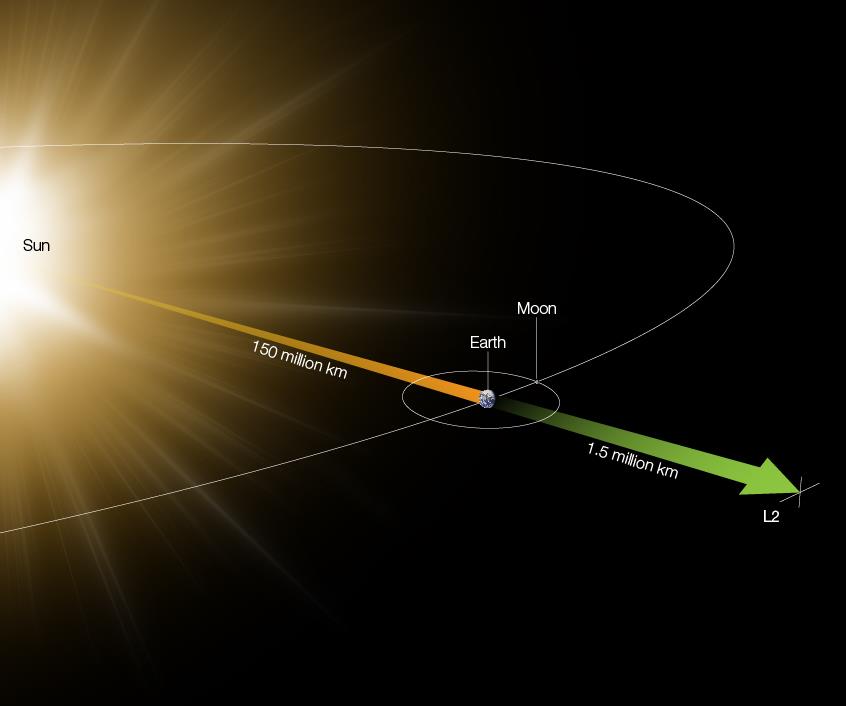About the James Webb Space Telescope
The James Webb Space Telescope is the most powerful space telescope ever built. Canada has contributed a scientific instrument and a guidance sensor to the massive observatory, which will enable breakthrough discoveries in astronomy.
- Launch:
- Status: Operational at Lagrange 2
Canada's contribution to the James Webb Space Telescope (Credits: Canadian Space Agency, NASA, Northrop Grumman, ESA)
Mission objectives
Webb is designed to:
- observe farther into the universe than ever before
- search for the first stars and galaxies created after the Big Bang
- better understand how planets, stars and galaxies are born and evolve over time
- explore distant worlds and study our solar system
- determine the potential for life on planets around other stars
Canada's role
The Canadian Space Agency (CSA) has provided the Webb Telescope with the Near-Infrared Imager and Slitless Spectrograph (NIRISS) scientific instrument and the Fine Guidance Sensor (FGS).
Thanks to the CSA's contribution, Canadian scientists are guaranteed observation time on the Webb Telescope and are among the first to benefit from Webb's powerful instruments.
How Webb works
Webb uses infrared light, which cannot be perceived by the human eye, to study every phase in cosmic history.
The telescope's four scientific instruments are specifically designed to capture infrared light, and are able to peer through cosmic dust to study colder or very distant objects.
There are many kinds of light all around us: the rainbow of light we can see, and several other types – like X-rays, infrared, microwaves, radio waves – that are not visible to the human eye.
Certain types of objects, such as planets and very distant galaxies, shine most brightly in infrared light. A variety of instruments have been built to capture these types of non-visible light and help study different celestial phenomena like exoplanets, red dwarf stars and black holes.
About the telescope
Webb is the result of over 20 years of planning and development. Several elements make the space observatory unique and help ensure it will meet its objectives:
- Golden mirror: Webb's primary mirror is 6.5 metres wide, making Webb the largest space-based telescope ever built. The mirror is made up of 18 hexagonal gold-coated beryllium segments that can be adjusted individually.
- Sunshield: To protect itself from the Sun's heat, Webb has a tennis court-sized sunshield. One of Webb's instruments also has a refrigeration system to keep it cool, because the heat from the Sun (and Webb's own instruments) would otherwise interfere with the telescope's observations.
- Deployment: Webb is so large that it needed to be folded up like a piece of origami to fit into the Ariane 5 rocket that launched it into space. It took Webb about two weeks to fully unfold, and two more weeks to travel to its final destination.
- Instruments: In addition to the Canadian-made scientific instrument NIRISS, the Webb Telescope houses three other partner-contributed scientific instruments: NIRCam (NASA), NIRSpec (European Space Agency [ESA]) and MIRI (NASA/ESA).
- High-frequency radio transmitter: Large radio antennas spread out around the globe receive Webb's transmitter signals and forward them to the Webb Science and Operation Center at the Space Telescope Science Institute in Baltimore, USA.
Where is Webb?
In addition to orbiting the Sun, Webb makes a tight orbit around a point in space known as Lagrange 2, or L2. This point is located 1.5 million kilometres from Earth. Its distant location gives Webb an unobstructed view of the sky, and aids its ability to see much farther into the universe than the Hubble Space Telescope.

Position of the Webb telescope in relation to the Sun, Earth, and the Moon - Text version
The graphic illustrates the second Lagrange point, or L2, which is 1.5 million kilometres from Earth, opposite the Sun. The Sun and Earth are 150 million kilometres apart.
The Webb Telescope orbits the Sun at a position called L2, located 1.5 million kilometres from Earth. (Credits: ESA, CSA)
| Mirror diameter | 6.5 m |
|---|---|
| Mirror collecting area | 25 m² |
| Sunshield dimensions | 21.2 m × 14.6 m |
| Height (deployed) | 12 m |
| Launch mass | 6,500 kg |
| Launch vehicle | Ariane 5 rocket |
| Launch site | Kourou, French Guiana |
| Solar array power | 2,000 W |
| Operating temperature | -233.2 °C |
| Wavelength coverage | Near- and mid-infrared light |

The Webb Telescope's four scientific instruments are housed together in a metal frame located behind the telescope's gold mirrors. (Credit: NASA)
Mission partners
Webb is an international collaboration between NASA, ESA and the CSA.
NASA's Goddard Space Flight Center manages the development effort. The main industrial partner is Northrop Grumman; the Space Telescope Science Institute operates Webb after launch.
